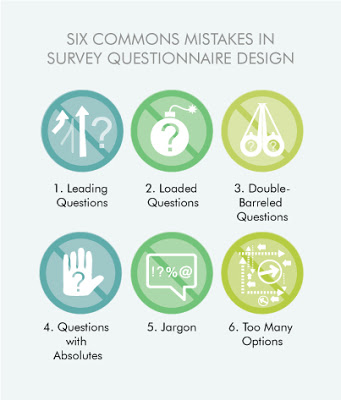Survey
Marketing Research 101: Six Commons Mistakes in Survey Questionnaire Design

Online surveys have become the cornerstone of the market
research industry. They quickly and easily allow businesses to gather
consumer data, which they can use to: enrich products, alter marketing
campaigns, and tailor messaging. Unfortunately, modern technology, which has
improved the ease with which companies can generate surveys and analyze
results, has also spawned an era where an increasing number of surveys are
poorly formulated, limiting responses or skewing data to misrepresent customer
intentions. By applying a few basic tenants of survey design, we easily
increase engagement and improve data accuracy and overall quality.
research industry. They quickly and easily allow businesses to gather
consumer data, which they can use to: enrich products, alter marketing
campaigns, and tailor messaging. Unfortunately, modern technology, which has
improved the ease with which companies can generate surveys and analyze
results, has also spawned an era where an increasing number of surveys are
poorly formulated, limiting responses or skewing data to misrepresent customer
intentions. By applying a few basic tenants of survey design, we easily
increase engagement and improve data accuracy and overall quality.
Questions that Affect
the Answer
the Answer
1. Leading
Questions: Questions should be phrased in a way that suggests all responses are
equally viable
Questions: Questions should be phrased in a way that suggests all responses are
equally viable
2. Loaded
Questions: Write questions that do not inherently encourage the participant to
be less-than-straightforward with the response
Questions: Write questions that do not inherently encourage the participant to
be less-than-straightforward with the response
Questions that Result
in Unclear Data
in Unclear Data
3. Double-Barreled
Questions: Questions that ask two things and offer only one opportunity to
answer do not provide usable data
Questions: Questions that ask two things and offer only one opportunity to
answer do not provide usable data
4. Questions
with Absolutes: Unless the subject is clear-cut (i.e., 'Are you a man'?), the
question should provide enough choices to represent participant response
with Absolutes: Unless the subject is clear-cut (i.e., 'Are you a man'?), the
question should provide enough choices to represent participant response
Questions that
Confuse
Confuse
5. Jargon: Unless
the participant pool is very specific, such a ward of doctors at a local
hospital, questions should avoid using abbreviations, industry-specific
language, or slang. Using clear, common language insures that 100% of the
participant pool has an equal understanding of the content
the participant pool is very specific, such a ward of doctors at a local
hospital, questions should avoid using abbreviations, industry-specific
language, or slang. Using clear, common language insures that 100% of the
participant pool has an equal understanding of the content
6. Offering
Too Many Options: Potential responses to online survey questions should be
limited to five or six. Offering more options can be confusing to the
participant, clutters the survey, and may negatively affect survey completion
Too Many Options: Potential responses to online survey questions should be
limited to five or six. Offering more options can be confusing to the
participant, clutters the survey, and may negatively affect survey completion
While
there is much more to online survey design than adhering to these six
principles, avoiding the most common errors of question formulation will
greatly increase a survey's return rate, accuracy, and relevancy.
there is much more to online survey design than adhering to these six
principles, avoiding the most common errors of question formulation will
greatly increase a survey's return rate, accuracy, and relevancy.
About the Author: As Global Marketing Associate, Tara Wildt leads
Lightspeed GMI's digital and interactive marketing platform, branding
initiatives and social media strategy. In her role, she develops creative
solutions and collateral for Lightspeed GMI's product suite and plays a key
role in the company's strategic development. In addition, she has oversight of
the company's philanthropic and community outreach initiatives.
Lightspeed GMI's digital and interactive marketing platform, branding
initiatives and social media strategy. In her role, she develops creative
solutions and collateral for Lightspeed GMI's product suite and plays a key
role in the company's strategic development. In addition, she has oversight of
the company's philanthropic and community outreach initiatives.

